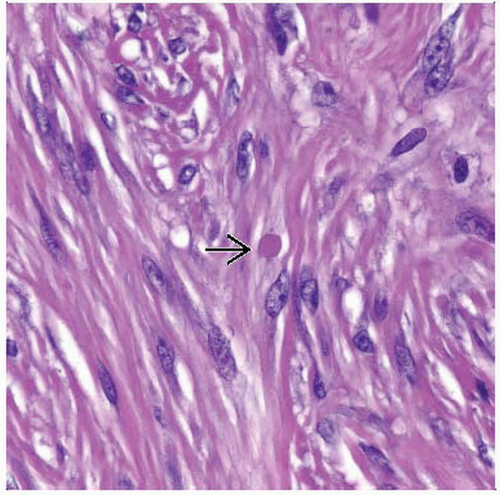Inclusion Body Fibromatosis
Thomas Mentzel, MD
Key Facts
Terminology
Benign proliferation of fibroblasts and myofibroblasts containing scattered eosinophilic inclusion bodies that occur on digits of young children
Clinical Issues
Rare fibroblastic/myofibroblastic neoplasm
Occurs usually in 1st year of life
Dorsal aspects of hands or feet
Digital enlargement
May recur locally; may show spontaneous regression
Extradigital soft tissues (i.e., arm, breast) are extremely rarely affected
Dome-shaped swelling overlying phalanges or interphalangeal joints
Treatment: Local excision with preservation of function
Macroscopic Features
Ill-defined neoplasms
Microscopic Pathology
Infiltrating fascicles
Uniform spindle-shaped tumor cells
No cytologic atypia
Intracytoplasmic eosinophilic spherical inclusions
Inclusions are trichrome(+)
Pale eosinophilic fibrillary cytoplasm
Ancillary Tests
Spindled cells show features of myofibroblasts
Expression of actins, desmin, calponin, and CD99
Inclusions show granular &/or filamentous features
Cytoplasmic filaments extend onto inclusions
 This photograph of a hand shows an exophytic, dome-shaped mass. Patients with inclusion body fibromatosis usually present with clinically evident masses. |
TERMINOLOGY
Synonyms
Infantile digital fibromatosis
Digital fibrous tumor of childhood
Reye tumor
Definitions
Benign proliferation of fibroblasts and myofibroblasts containing scattered eosinophilic spherical inclusions that occur on the digits of young children
CLINICAL ISSUES
Epidemiology
Incidence
Rare fibroblastic/myofibroblastic neoplasm
Age
Occurs usually in 1st year of life
Very rare in adult patients
Gender
M = F
Site
Dorsal aspects of hands or feet
Rarely synchronous or asynchronous involvement of more than 1 digit
Thumb or big toe is only very rarely affected
Extradigital soft tissues (i.e., arm, breast) are extremely rarely affected
Presentation
Digital enlargement
Dome-shaped swelling overlying phalanges or interphalangeal joints
Nontender nodules
Rarely erosion of bone
Natural History
May recur locally
May regress spontaneously
No progression
No metastases
Treatment
Surgical approaches
Local excision with preservation of function
Prognosis
Excellent overall prognosis
May recur locally
May show spontaneous regression
Main prognostic indicator represents adequacy of primary excision
MACROSCOPIC FEATURES
General Features
Ill-defined neoplasms
Dermal neoplasms with gray-white, indurated cut surfaces covered by intact skin
No areas of hemorrhage
No areas of necrosis
Size
Nodules of variable size
Nodules usually measure < 2 cm
MICROSCOPIC PATHOLOGY
Histologic Features
Infiltrating fascicles and sheets
Uniform spindle-shaped fibroblasts and myofibroblasts
No cytologic atypia
Elongated spindled nuclei
Pale eosinophilic fibrillary cytoplasm
Intracytoplasmic eosinophilic spherical inclusions
Stay updated, free articles. Join our Telegram channel

Full access? Get Clinical Tree




